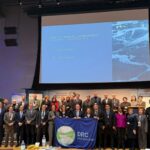The EUSDR managing/programming authorities Network meeting on 12 November 2024 brought together over 100 experts. Interreg and mainstream funding programmes, EUSDR Priority Area Coordinators and National Coordinators, macro-regional strategies (MRS) Supporting Units, representatives of the European Commission and other stakeholders exchanged ideas on how to develop joint activities and enhance the efficiency and impact of programme-MRS cooperation in the field of Embedding.
The meeting aimed to actively align the embedding process in a two-way approach: active embedding from the EUSDR’s point of view and active embedding from a programme’s point of view.
The representative of the Austrian EUSDR Presidency, Roland Arbter, opened the meeting, appreciating the renewed momentum and significance of the embedding process within the EUSDR reflected in the large number of participants. Mr Arbter also highlighted that one of the Austrian EUSDR Presidency’s aims was to actively work on close links between the Danube Region Strategy and EU programmes, especially with the outlook beyond 2027.
Austrian EUSDR Presidency and the Danube Strategy Point prepared the Embedding Guidance Paper 2024, titled “Active Embedding & Planning Ahead”. The paper outlines practical steps for the further alignment of the EUSDR and funding programmes in the current implementation phase. Secondly, it contributes to the discussion on embedding post-2027. Building on specific experiences in Austria in working on embedding with Interreg programmes, a focus is given to the question of how to build embedding links between the EUSDR and the Interreg programmes. Therefore, ‘active embedding’ steps from the EUSDR – what the Strategy can offer to programmes – are analysed in the Guidance Paper 2024 based on the (Interreg) programme cycle. In addition, an alignment of existing activities and proposals developed for concrete active involvement in the various areas of the (Interreg transnational/CBC) programme cycle that go beyond the EUSDR were presented.
The Austrian EUSDR Presidency has provided platforms and qualitative inputs for a debate about major trends and policy developments, which will shape future cooperation in the Danube Region. Based on the “Regional and spatial trends in the Danube Region and related integration developments” study (developed by wiiw), the first results identified evidence-based narratives to guide future cooperation, policy-making, and development trends in the Danube Region, with a focus on regional integration, economic challenges, and future cooperation strategies. Further, the study “Think Piece on the need to step up cooperation to master future challenges in the Danube Region” (developed by Spatial Foresight) found that transformations meet the Danube Region in specific ways, highlighting the importance of cooperation to shape the future. These two main ideas were developed into ten key messages focusing on future cooperation.
During the discussions, representatives of the EUSDR Priority Areas outlined their future plans of embedding (Priority Area 8 – Competitiveness, Carmen Hawkins and Helia Kovačević Grčić), showed specific projects or emphasised the need for closer cooperation on strategic projects assessment, suggesting a joint approach between programmes and MRS stakeholders to improve funding decisions and maximise long-term impact (Priority Area 6 – Biodiversity, Landscapes and Quality of Air and Soil, Florian Ballnus). From the programmes’ point of view, the representative of the Interreg Alpine Space Programme, Christina Bauer, noted the importance of better connecting Interreg CBC programmes and macro-regional strategies, which requires increased outreach. Others also pointed out the need to connect with the mainstream programmes.
Danube Region Programme’s representative, Gabriel Johannes, provided an overview of the Seed Money Facility (SMF) for 2024, highlighting its structure, funding, and assessment processes. The SMF call was launched to initiate strategic projects in alignment with the EUSDR Action Plan, resulting in 36 approved projects with a total budget commitment of 2.7 million EUR. Lessons learned emphasised the added EUSDR ownership from Priority Area Coordinators’ involvement, noting the assessment’s complexity and the challenge of supporting projects from the seed stage to impactful outcomes.
Another important topic on the agenda approached the cooperation actions of embedding and utilisation in the next Multiannual Financial Framework (MFF) post-2027. A solution for improved cooperation and shared commitment came from Priority Area 10 – Institutional Capacity & Cooperation, Claudia Singer-Smith, who proposed elaborating a joint position among EUSDR managing and programming authorities to tackle performance-based funding, programme implementation and cooperation challenges. Ms Singer-Smith added that MRS could provide a long-term vision, and early discussions about cooperation are essential to avoid late-stage considerations.
Ilze Cigaska from the Interact Programme presented two online tools that allow the sharing of information across programmes: Interactive tool 2021-2027 and Index I Interreg Data Exchange, as resources to facilitate cross-regional collaboration within the 2021-2027 period. Ms Cigaska also underscored the new priorities post-2027, namely:
• Cohesion Policy a key driver of EU reforms and investments,
• Emphasis on aligning cohesion policy with EU strategic goals, such as competitiveness, green and digital transitions, and economic and social resilience,
• Increased focus on stakeholder input, particularly regarding programme performance, sustainability, and governance flexibility,
• The role of MRS is to create joint long-term visions, enhance political backing, and increase impact through targeted collaborations that embed project results into regional strategies.
With a clear focus on the strategic alignment of programmes and the Danube Region Strategy, the meeting provided an essential platform for sharing best practices, discussing challenges, and strengthening connections across the Danube Region. It also pointed out the further need to work in a cooperative manner, bearing in mind the necessity of MRS and programme cooperation. Additional meetings were envisaged for 2025 to jointly provide solid and tangible approaches for the future of Cohesion policy and the Danube Region.
Presentations:
Danube Region Programme: EUSDR – Seed Money Facility 2024
Euro-MED Programme: Making the Mediterranean Green Transition Happen




